Effects of dopamine depletion on LFP oscillations in striatum are task- and learning-dependent and selectively reversed by l-DOPA
Author(s)
Lemaire, Nune; Ledia, F. Hernandez; Hu, Dan; Kubota, Yasuo; Howe, Mark William; Graybiel, Ann M.; ... Show more Show less
DownloadLemaire-2012-Effects of dopamine depletion on LFP oscillations.pdf (951.3Kb)
PUBLISHER_POLICY
Publisher Policy
Article is made available in accordance with the publisher's policy and may be subject to US copyright law. Please refer to the publisher's site for terms of use.
Terms of use
Metadata
Show full item recordAbstract
A major physiologic sign in Parkinson disease is the occurrence of abnormal oscillations in cortico-basal ganglia circuits, which can be normalized by l-DOPA therapy. Under normal circumstances, oscillatory activity in these circuits is modulated as behaviors are learned and performed, but how dopamine depletion affects such modulation is not yet known. We here induced unilateral dopamine depletion in the sensorimotor striatum of rats and then recorded local field potential (LFP) activity in the dopamine-depleted region and its contralateral correspondent as we trained the rats on a conditional T-maze task. Unexpectedly, the dopamine depletion had little effect on oscillations recorded in the pretask baseline period. Instead, the depletion amplified oscillations across delta (∼3 Hz), theta (∼8 Hz), beta (∼13 Hz), and low-gamma (∼48 Hz) ranges selectively during task performance times when each frequency band was most strongly modulated, and only after extensive training had occurred. High-gamma activity (65–100 Hz), in contrast, was weakened independent of task time or learning stage. The depletion also increased spike-field coupling of fast-spiking interneurons to low-gamma oscillations. l-DOPA therapy normalized all of these effects except those at low gamma. Our findings suggest that the task-related and learning-related dynamics of LFP oscillations are the primary targets of dopamine depletion, resulting in overexpression of behaviorally relevant oscillations. l-DOPA normalizes these dynamics except at low-gamma, linked by spike-field coupling to fast-spiking interneurons, now known to undergo structural changes after dopamine depletion and to lack normalization of spike activity following l-DOPA therapy.
Date issued
2012-10Department
McGovern Institute for Brain Research at MITJournal
Proceedings of the National Academy of Sciences of the United States of America
Publisher
National Academy of Sciences (U.S.)
Citation
Lemaire, N., L. F. Hernandez, D. Hu, et al. Effects of Dopamine Depletion on LFP Oscillations in Striatum Are Task- and Learning-dependent and Selectively Reversed by L-DOPA. Proceedings of the National Academy of Sciences 109(44): 18126–18131, 2012.
Version: Final published version
ISSN
0027-8424
1091-6490